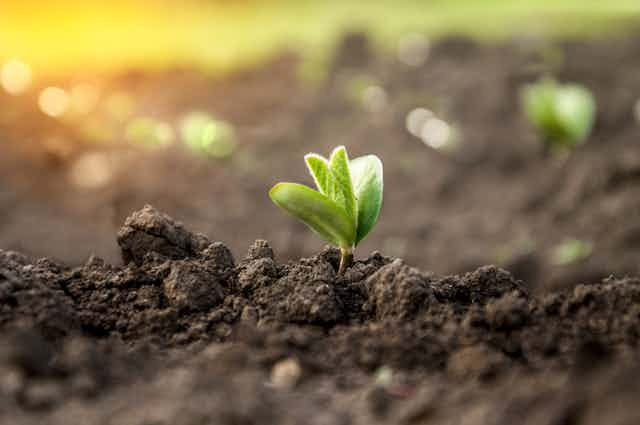Soils around the world are running low on potassium, a key nutrient needed for plants to grow. This ultimately means we may not be able to grow enough food for everyone.
But it’s not too late: we have just published research identifying six things we must do to safeguard potassium supplies and food production.
Potassium is required for plant growth alongside nitrogen and phosphorus (known as kalium in latin, potassium is the K in NPK fertilisers). While nitrogen and phosphorus sustainability issues are widely known, potassium remains in the shadows. Yet around 20% of agricultural soils worldwide grapple with potassium deficiency, especially in east Asia, south-east Asia, Latin America and sub-Saharan Africa.
Globally, more potassium is being extracted in harvests – small quantities of potassium are essential for every crop we grow – than are being added to fields in fertilisers. This unsustainable phenomenon is known as soil-nutrient mining.
For instance around 75% of China’s rice paddy soils and 66% of southern Australia’s wheat belt don’t have enough potassium. In India, a lack of potassium is already causing smaller crop yields.
Although it may seem straightforward to address the issue by adding more potassium to the soil, the reality is far more complex.
Supplies are concentrated in a few countries
Potassium is generally extracted from potash, a crystal-like mineral found in layers of underground rocks. The world’s reserves are concentrated in a handful of countries which means most other countries rely on imports, making their food systems vulnerable to supply disruptions.

Canada, Belarus and Russia collectively possess around 70% of the world’s potash reserves. Together with China, those four countries produce 80% of the global output and dominate a US$15 billion (£12 billion) international market for potassium fertiliser.
Potash prices are prone to volatility and there have been two big spikes since 2000. The first was in 2009, when prices more than tripled. Despite widespread concern about fertiliser-driven food price instability, little action was taken to shield against future shocks.
In 2021 increased fertiliser demand, post-COVID-19 economic recovery, Russia’s invasion of Ukraine and soaring fuel costs led to another rapid price escalation. Sanctions on Belarus added to the disruption. By April 2022, potash was six times more expensive than it had been in January 2021.
Prices have since dipped a little. While this respite may be welcome, the volatility underscores the pressing need to fortify agriculture against unforeseen shocks.
Potash mining also has a considerable environmental impact. For each tonne of potassium that is extracted, around three tonnes of mine waste is generated – mostly salt. This is generally left piled up in “salt mountains”. Without proper management that salt can be washed by rains into surrounding rivers and groundwaters where it can significantly damage ecosystems.

We also still don’t know exactly what impact increasing potassium concentrations from fertiliser use will have on life in rivers and lakes. Certainly in lab studies it has proven highly toxic to a range of animals. We need to know more about this before we support simply putting more potassium in soils.
Six things we must do
To address soil potassium deficiencies and guard against yield fluctuations, price volatility and environmental impacts, we propose six targeted actions:
1. Review current potassium stocks and flows. We still don’t have a global assessment of potassium soil stocks which would identify at-risk countries and regions.
2. Get better at predicting price fluctuations. With volatile potassium prices causing food price spikes, we’ll need to develop our monitoring and forecasting capabilities. An international scheme for reporting potassium resources would give us better data.
3. Help for farmers. “Sufficient” potassium levels should be defined for each area, based on local assessments considering things like how much potassium was already in the soil and what crops are grown there. There could then be targeted fertiliser recommendations for local farmers.
4. Evaluate the environmental effects. We need to synthesise all available evidence on environmental damage from potash mining, and a potential increase in potassium fertilisers. We especially need to know what it means for rivers and lakes. Potash alternatives such as polyhalite (a potassium mineral with a lower chloride content) should be considered.
5. Develop a circular potassium economy. Potassium can be recycled and reused. Creating a circular potassium economy will mean capturing more potassium from human and animal sewage and adding it back on crops to grow more food, so we can eat it again, and so on. Promote diets with lower potassium footprints to reduce reliance on mined potassium sources.
6. More cooperation between governments. Similar to actions on phosphorus and nitrogen, we need an intergovernmental mechanism to consolidate knowledge on potassium, set globally agreed targets and quantify economic benefits.
As phosphorus and nitrogen gain global attention, potassium must not be left behind. A proposal for a resolution on potassium at a future United Nations environment assembly holds the key to intergovernmental action, setting the stage for positive change and integrated nutrient management to achieve global biodiversity targets.

Don’t have time to read about climate change as much as you’d like?
Get a weekly roundup in your inbox instead. Every Wednesday, The Conversation’s environment editor writes Imagine, a short email that goes a little deeper into just one climate issue. Join the 30,000+ readers who’ve subscribed so far.

